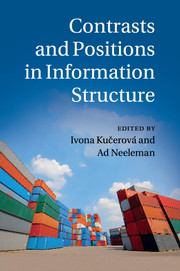Book contents
- Frontmatter
- Contents
- List of Contributors
- 1 Introduction
- Part I The architecture of grammar and the primitives of information structure
- 2 Predicate integration: phrase structure or argument structure?
- 3 Wh-intonation and information structure in South Kyeongsang Korean and Tokyo Japanese
- 4 Grammatical marking of givenness
- 5 Interface configurations: identificational focus and the flexibility of syntax
- 6 Focus and givenness: a unified approach
- 7 The locality of focusing and the coherence of anaphors
- Part II Exploring the interfaces: case studies
- Bibliography
- Index
5 - Interface configurations: identificational focus and the flexibility of syntax
from Part I - The architecture of grammar and the primitives of information structure
Published online by Cambridge University Press: 05 August 2012
- Frontmatter
- Contents
- List of Contributors
- 1 Introduction
- Part I The architecture of grammar and the primitives of information structure
- 2 Predicate integration: phrase structure or argument structure?
- 3 Wh-intonation and information structure in South Kyeongsang Korean and Tokyo Japanese
- 4 Grammatical marking of givenness
- 5 Interface configurations: identificational focus and the flexibility of syntax
- 6 Focus and givenness: a unified approach
- 7 The locality of focusing and the coherence of anaphors
- Part II Exploring the interfaces: case studies
- Bibliography
- Index
Summary
Introduction
Current mainstream transformational syntax draws heavily in its account of discourse-related movements on two key classes of syntactic objects: (i) discourse-related functional heads, determining syntactic positions for the moved elements as a function of their own location in the clausal hierarchy; and (ii) discourse-related uninterpretable features, triggering movements to these positions. Elements coming to occupy the respective syntactic positions thus defined are correlated with some special discourse status.
The postulation of (i) and (ii) raises disturbing methodological and empirical issues. Many of these are not specific to the syntax of discourse-related movements, but are of a more general nature, and concern the ‘cartographic approach’ (CA) to syntax in general (see, e.g., Newmeyer 2008; Craenenbroeck 2009; and references therein). Even though the CA does not enrich the grammatical apparatus of the standard minimalist model, it does expand the range of lexical primitives: syntactically projecting functional morphemes F, formal features determining the hierarchical position of F, and formal features defining the set of phrasal elements that F can be associated with, whether via movement or by base-generation. While these devices are helpful in broadening empirical coverage, their postulation should be firmly restricted, as their overzealous introduction to the model runs the risk of unleashing inflated descriptive power.
- Type
- Chapter
- Information
- Contrasts and Positions in Information Structure , pp. 87 - 101Publisher: Cambridge University PressPrint publication year: 2012
- 3
- Cited by



